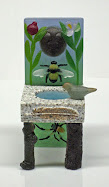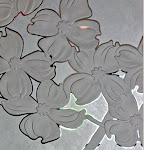OK, so this is what I've been doing for the last couple of weeks.
Trying to get this job finished!
warning...tech talk.
I've been cutting the design shapes out of fiber paper in three thicknesses...1/8”, 1/16” and 1/32”. To do this, I use transfer paper to mark the lines of the pieces and cut them out with a hobby knife.
some of the fiber paper shapes (taped to cardboard for transport)
The first panel we did, laid out on thin-fire (a refractory paper that basically turns to dust after it is fired and takes the place of kiln wash which is stuff you paint onto your kiln shelf to keep the glass from sticking to the shelf during firing) had several problems. First it wasn't at high temperature long enough so that it did not slump or fuse completely and had big elongated bubbles around all the design elements. Also, the thin-fire cracked and separated before the glass slumped down enough to touch the surface, leaving impressions of the 'cracks'.
first attempt at first panel after firing
left - thin-fire 'crack' impressions running through the panel; right - funky bubbles
I set up the second panel (also on the thin-fire), we stacked the three sheets of glass and started the kiln after adjusting the firing schedule, a little longer time at a little higher temperature. Then we sat around discussing the process. I guess I had thought that Gene had more experience with this technique than he actually did. He had done three jobs, all the panels smaller than the ones I was doing, and only using two layers of glass (my customer wanted a heavier glass look, hence the three layers). We looked at the sample pieces he had in his shop of the jobs he had done and then he remembered that he had fused his glass together first and then slumped it. Two separate firings and we were trying to do these in one. I suggested we stop the kiln and fuse these panels together first but it was already too hot, would have taken too long for it to cool down enough so we just went ahead. I was concerned that we were using so much of the Bullseye tekta glass which is kind of pricey. My budget on this job, already underpriced, would not allow me to spend all that money. Gene assured me he could re-use the glass and I would only have to pay for the glass one time.
The second panel came out much better. It fused and slumped completely but still had the thin-fire 'cracks' and the bubbles around the elements which were smaller and round this time. I was ready to re-do the first panel, having cut out all the shapes again (the fiber paper can only be fired once) and Gene had already fused the blank, only this time we decided to not use the thin-fire and slump on the kiln washed shelf.
second attempt at panel 1 with pre-fused blank
Unfortunately this is becoming a rather steep learning curve. We started the firing right in the middle of that really cold weather and Gene's kilns are in an enclosed outdoor area. Apparently, the panel cracked on the way up (a combination of the cold weather and heating it up too fast) and fused back together leaving several jagged crack lines in the finished piece. Sheesh! Other than that, it came out great. No funky bubbles lining the design elements, no thin-fire crack marks.
jagged crack lines running through second attempt at panel 1
So yesterday, the re-do of the second panel went into the kiln. Gene slowed down the firing schedule so hopefully this one will come out right and we can proceed to the others.
second attempt at panel 2 with pre-fused blank
I think if I do this technique again, I will use plate glass even though it does have that greenish/blueish cast to it but it is so much more affordable. Of course, we'll have to go through another learning curve with a different glass, but surely it won't be as steep.

















I guess I should be glad that when I mess up in my job it's usually just a piece of paper :)
ReplyDeleteSo much work - but looks like the end product will be beautiful and well worth it.
ReplyDeleteellen - wow! i really love following the work/craft thread of the creative journey you undertake for each of your pieces. thanks very much for sharing it here. steven
ReplyDeleteEducation is expensive!
ReplyDeleteI can still see beauty in the mistakes.
A huge amount of work goes into your creations,
ReplyDeleteno wonder the end result is as spectacular as the work you show us.
Wow.. that's a lot of trial and error at what I'm sure is quite an expense. Your finished pieces are always so beautiful, though.
ReplyDelete::shaking my head:: absolutely amazing.
ReplyDeleteWow.
I want to win the lottery. My biggest indulgence would be "Ellen Glass" in every window.
So neat.
Ellen this is exquisite! I love your tech talk - and I always feel so nerve-wracked, reading about what you do. Wow! So much work - and so many things that could go wrong in the process.
ReplyDeleteBeautiful!
I am amazed at all that goes into one of your creations. I look forward to seeing the end result of your creative hands.
ReplyDeleteOuch! Hate those steep learning curves.
ReplyDeleteSorry to hear you are having such a rough time with this job. Hope the second / third? attempt came out well. If you do work with this glass again, perhaps you will save some time having gone through the trial and error stage already.
ReplyDeleteACK! That is so amazing to me!
ReplyDelete